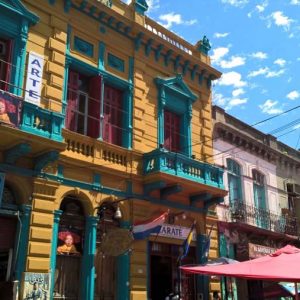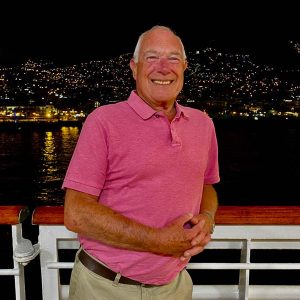Here’s a good pub quiz question: can you connect a 7th century founder of monasteries with a popular nut and cocoa spread? Read on. The answer will come at the end.
The monastery builder was St. Philibert. You may see his stone sarcophagus in the abbey in a town named after him: St. Philbert de Grand Lieu, in west central France. It weighs two tonnes. According to legend, monks carried it there from his initial resting place on the island of Noirmoutier, off the coast of the Vendée, when looting Norse raiders threatened to pilfer his relics.
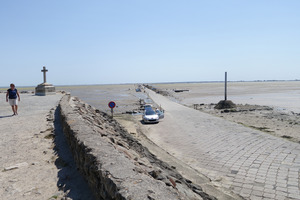 Since this was a journey of some 35 miles and involved a sea crossing, you must take the story with a pinch of salt. There’s plenty of that on Noirmoutier.
Since this was a journey of some 35 miles and involved a sea crossing, you must take the story with a pinch of salt. There’s plenty of that on Noirmoutier.
There’s no indication that the Passage de Gois existed in 836, when the monks fled. In any case they could hardly have got the sarcophagus across between the daily ebb and flow of tides. Today the causeway, first mentioned on a map in 1701, is one of Noirmoutier’s unmissable sights. It’s 2.58 miles long. It hosts an annual running race. The Tour de France has crossed it. On either side at low tide, locals venture onto the expanse of mud in search of shellfish. At either end is a dire warning of what can happen when the tide comes in.
Noirmoutier is now linked to what locals call “le continent” by a bridge. It’s a charming place, best seen by rented pushbike or on foot: single storey cottages with red roof, the odd fin de siècle mansion in the trees, the inevitable supermarkets but no glaring high rise horrors. The sandy beaches are extensive and – while I have no first hand experience of the French summer peak there – relatively uncrowded. In early July the Atlantic was warm. It appeared cleaner and calmer on the north side of the island.
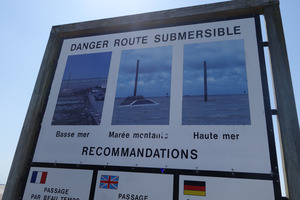 We walked along that shore, sometimes barefoot, to he 1.5km long Jacobsen jetty built some 200 years ago as a towpath from which boats might be hauled against the wind into the town harbour of Noirmoutier en I’Île. Today it’s open only to cyclists and walkers. It protects a wetland reserve, where avocets and redshanks strutted, and shelducks gathered in abundance. The town has a pleasant, pedestrian only area, with a good selection of restaurants and shops.
We walked along that shore, sometimes barefoot, to he 1.5km long Jacobsen jetty built some 200 years ago as a towpath from which boats might be hauled against the wind into the town harbour of Noirmoutier en I’Île. Today it’s open only to cyclists and walkers. It protects a wetland reserve, where avocets and redshanks strutted, and shelducks gathered in abundance. The town has a pleasant, pedestrian only area, with a good selection of restaurants and shops.
In La Guérinière there’s the marvelous Museum of Traditions, founded to “safeguard the last vestiges” of an insular existence now overtaken by modernity. Its fascinating collection includes furniture, tableware and clothes, a horse drawn hearse that functioned until 1970 – and provides a detailed explanation of the way salt is collected.
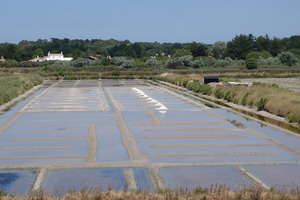 Sea salt is major industry, originally crucial to the preservation of food and now given second wind but tourism and demand for natural food. A significant area of the island is occupied by the small rectangular drying pans, known as oeillets, signaled from a distance by conical white salt piles. We buy five kilos from a kiosk by a roundabout – for less than £4.
Sea salt is major industry, originally crucial to the preservation of food and now given second wind but tourism and demand for natural food. A significant area of the island is occupied by the small rectangular drying pans, known as oeillets, signaled from a distance by conical white salt piles. We buy five kilos from a kiosk by a roundabout – for less than £4.
Bonnottes – potatoes much prized by chefs – are another source of income. Their flavour has been hymned in the manner of a fine wine, with praises heaped on their hints of lemon and walnut and their long, salty finish. They were long reputed to be the world’s most expensive, partly because they were grown in such a limited area and partly because they are harvested by hand. But recently they have been grown in similar conditions in Jersey and at least one UK supermarket chain has offered them at bargain prices.
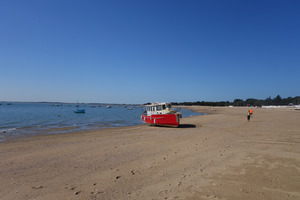 Our hotel was Les Prateaux, on the seaward edge of the town. A gate from the grounds – secured by code – opened on to woodland a short walk from two beaches and a few pleasant bars and eateries overlooking the sea. Our room was large and airy, with a balcony above the hotel garden. The restaurant was sufficient that we weren’t tempted, during a short stay, to eat out: good fresh John Dory and halibut and, on one evening, a memorable lobster carpaccio. There was also an extraordinary dessert incorporating asparagus and potatoes – both whipped into a mousse (I’m unsure whether the latter were bonnottes) and served with grapefruit and chocolate. If the waiter’s description raised our eyebrows the fact that it worked was even more surprising.
Our hotel was Les Prateaux, on the seaward edge of the town. A gate from the grounds – secured by code – opened on to woodland a short walk from two beaches and a few pleasant bars and eateries overlooking the sea. Our room was large and airy, with a balcony above the hotel garden. The restaurant was sufficient that we weren’t tempted, during a short stay, to eat out: good fresh John Dory and halibut and, on one evening, a memorable lobster carpaccio. There was also an extraordinary dessert incorporating asparagus and potatoes – both whipped into a mousse (I’m unsure whether the latter were bonnottes) and served with grapefruit and chocolate. If the waiter’s description raised our eyebrows the fact that it worked was even more surprising.
Hazelnut chocolate would make a suitable dessert on Noirmoutier. Filbert, an alternative English name for the nut in Nutella, is believed to derive from Philibert, the much travelled saint who pitched up there. Why? Philibert’s feast day is on August 20 – the date by which filberts are supposed to ripen. Obscure connections: they’re among the joys of travel.
More information
Roger Bray travelled on P&O Ferries’ Dover-Calais service. The drive to Noirmoutier en I’Île takes around 6 – 7hrs. We broke the journey with an overnight stay near Sées in Normandy. Three nights at the Hotel Les Prateaux – with meals and wine, cost €588 – or about £420 are the current exchange rate.


